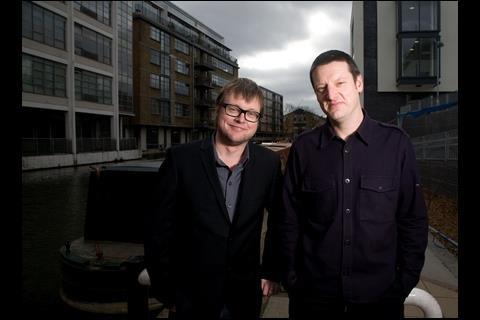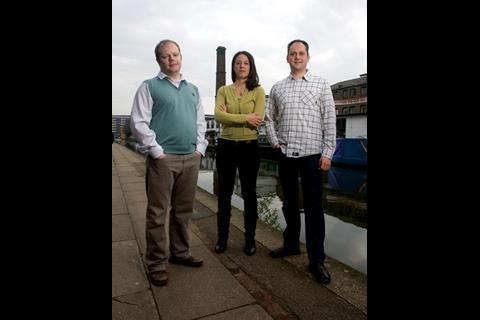You may not even know that you need them, but the companies featured here can do marvellous things for your business. Roxane McMeeken makes the introductions
Many of the industry’s innovators – those that have invented new ways of solving problems, working more efficiently, saving money and building sustainably – are small firms. These cutting-edge companies are cutting edge because they can change shape quickly, seek out new niches and develop innovations to suit emerging trends. The problem is, of course, is that they are hard to meet.
In fact, unless you’ve read the Building Awards shortlist, you might not know their names or be aware that the services they offer exist. You won’t find it easy to discover their identities, either, because many are not on frameworks and don’t come to industry dos. But these firms are well worth seeking out, so Building has talent-spotted the small consultants that are doing things a bit differently – and thriving.
SEArch Architects, Lincolnshire
SEArch’s five staff specialise in earth-sheltered housing. In the last financial year it had a £300,000 turnover and a £40,000 operating profit. It is the oldest of our 10 firms, being launched 1991.
Clients include: Wherry Housing Association in Norwich, for which it is designing the UK’s first earth-sheltered social housing scheme.
Jeremy Harrall, the practice’s founder, spent nine years researching earth-sheltered buildings for his doctorate before deciding to start building them. He now has a portfolio of 22 of them, including his own home, which he built seven years ago. The main advantage of this type of housing, in which earth is packed against the building’s walls to supply external thermal mass, is that they are so well insulated that little heating is required.
Harrall says: “I’ve used the business to deliver my personal aspirations and I have deliberately avoided growth because I was concentrating on research – but I’m now ready to offer what we do to a wider market.” This year he plans to hire more staff and will be aiming to work on projects worth more than £2m.
Mason Navarro Pledge
(Pictured right, top)
Despite having only 13 staff, this Hertfordshire-based engineer offers a broad mix of skills. It is 10 years old, has a turnover of £1.1m and made a £250,000 operating profit in 2008/09.
Clients include: BRE, Mercedes-Benz and the 480-unit New Homes project for Luton council.
MNP was started by three engineers: retail specialist Stuart Pledge, listed buildings expert David Mason and prisons specialist Frank Navarro (pictured right, top - left to right). Their combined expertise means their firm can do just about anything, from restoring churches to designing a skate park in Camden. It can even undertake highly specialised tasks, such as designing buildings able to withstand missile blasts for a defence client. Pledge says: “Our portfolio is very diverse; we think it’s better not to put all your eggs in one basket.”
Workload breaks down into 10% public sector, 35% new-build residential, 25% commercial and the remainder sprinkled over special projects such as historic buildings. So far, all work has been in the UK but the firm has just won a job in Libya.
MNP aims to create a dynamic working environment, with most staff in their thirties, and has a flat structure. “Everyone is empowered to win work. We think that helps us attract a wider base,” says Pledge. “This year we’re hoping to expand further into hotels, historic palaces and defence.”
The firm has a strong IT bias. Pledge says: “Although we’re small, we’ve resourced up our IT so we can offer advanced modelling and analysis.” This has helped the firm win work on cutting edge projects such as advising on the structural aspects of Wates’ green refurb of a Victorian house on BRE’s estate.
Thomson Gray
This Edinburgh QS has just 16 staff, but it plays a big role in the Scottish healthcare scene – so big that it made an impressive £150,000 operating profit on turnover of £1.1m in the last financial year. It was launched in 2004.
Clients include: Royal Hospital for Sick Children, Edinburgh; Royal Victoria Hospital Reprovision project, Lothian; Musselburgh Community Treatment Centre; Edinburgh Castle; the Royal Yacht Britannia.
Unusually for a small firm, Thomson Gray has made it onto NHS and university frameworks. Ron Thomson, the business’ co-founder, who is a former partner in Gardiner & Theobald, says: “Believe it or not, 2009 was the best year we’ve had. We’re recruiting at the moment and people say we’re lucky to be on these frameworks, but it’s more than just luck: we’re obviously doing good work.”
Thomson is prepared for the widely expected slump in public sector work, which currently makes up almost two-thirds of his workload. He plans to build up a new business line advising clients on capital allowances and construction tax.
Provelio
This project manager’s 35 staff work in a former Quaker church in Bristol. The company has a £3m turnover and made a £700,000 operating profit in 2008/09. It was launched 2002 by former Currie & Brown staff.
Clients include: The main client is Bristol university, but it also works for the Health Protection Agency, the Royal United Hospital in Bath and Bath & North East Somerset council.
Everyone at Provelio is required to do a masters degree. Paul Wilson, one of the firm’s founding directors, says: “People who are good practically are not always fully versed in the theory of what they’re doing, which means if something goes wrong they don’t know why. So we hire practical people and give them academic training.”
This approach is used to work with any client with a large estate. “We take an academic approach to jobs – we study what the client wants, we try to really understand the problem and then we apply what we’ve learned practically.” This focused approach has led to jobs ranging from personality profiling of client teams to a heating project where the scrap value of old boilers was used to fund a plumbing apprenticeship for a young woman at Stroud college.
Robert Wynter & Partners
This 18-person firm specialises in using engineering to save money. Launched in 1997, its fee income will be around £600,000 this year and profit will be between 5% and 10%. It has offices in Dorking, Cornwall … and Bulgaria.
Clients include: Crest Nicholson, Barratt, mosques, churches, schools, Barking & Dagenham college and Esher college.
Robert Wynter was working at WSP when he realised he wasn’t happy inside a big firm. “Like many other engineers, my brain is wired differently from other people’s and as I got higher up the ladder I found I was doing less engineering and more politics, and that doesn’t suit engineers.”
He began working at night for a colleague who had gone freelance, designing spreadsheets that took the mind-bending work out of the calculations needed to design wind farms. In 1997, he felt he had built up enough work with wind farm company Ocean to strike out on his own. Unfortunately, Ocean was a major client of Enron, and the day after Wynter went into business alone, the Enron scandal broke.
Just before he gave up, an ex-colleague asked him to apply his money-saving engineering techniques to the Gants Hill housing project for Crest. He managed to shave £1.5m off the cost of the scheme’s £7.5m structural steel package, and has been working for Crest ever since. Other clients have come on board, including work won through a Bulgarian recruited in the UK who now runs a eight-strong office in the country.
King Shaw Associates
This Bath-based engineer’s particular skill is using physics to understand the construction process. The 12-person firm has a turnover of £850,000 and made a £40,000 loss in 2008/09. It was launched in 2002.
Clients include: The Innovate Green Office in Leeds emits 80% less carbon than a standard building, which is the best BREEAM rating for an office in the UK. It is also working on the UN building in Montenegro, which has yet to be built.
Co-founder Doug King’s practice offers building and structural engineering services, but has a focus on sustainability. King has been vocal in the media about the misuse of green technologies and coined the term “eco bling”, meaning green accessories added to buildings more for show than function. He aims to make sure his firm avoids this superficial approach.
King and his business partner are physicists turned environmental engineers (both worked for Buro Happold) and they take an analytical approach to sustainability. He says: “We look at the science behind the building process and we emphasise passive techniques. We design buildings that are not over-reliant on unnatural energy and make sure this is fundamental to the building, not just clamped on at the end.”
Eckersley O’Callaghan Structural Design
This six-year-old engineering firm specialises in glass work and quirky projects. It is based in London but works all round the world. It has 14 staff, a £2m turnover but declines to reveal its profit.
Clients and projects include: Apple stores, the ship in the bottle sculpture planned for Trafalgar Square’s fourth plinth, artist Anish Kapoor’s wax-fuelled cannon at the Royal Academy and the Ivy restaurant in Covent Garden.
This firm’s co-founders, Brian Eckersley and James O’Callaghan, (pictured, top), say their company’s approach is to evolve as it grows. Eckersley says: “Our work for Apple has become a long-term research project because each new job builds on the technology we developed on the last one.”
Working for international clients such as Apple means that despite its small size, Eckersley O’Callaghan does only half of its business in the UK. “People seem to track us down because we’re glass experts,” says Eckersley. Above all, the firm’s projects must be complex, he says. “We are not in the business of knocking out basic things. A lot of our work with structural glass, for example, is highly analytical and pushes the edges of the technology available.”
He adds: “We get involved in lots of weird and wonderful projects. They’re not that lucrative to be honest, but we enjoy them.”
Even so, the firm has not had to make redundancies in the recession and is looking for a new member of staff, although it is no longer growing its workforce at its previous rate of 50% a year. Eckersley puts this resilience down to the firm’s international spread of work.
The firm has just finished a more traditional UK project, however – an elegant timber-decked bridge over the Leeds and Liverpool canal in Bootle, Merseyside.
Southfacing
This London-based sustainability expert develops software to help design low-carbon buildings. It has 10 staff who generated a turnover of £400,000 and a profit of £11,000 in 2008/09. It is five years old.
Clients include: Despite its small size, Southfacing is working on four jobs for the London Olympics: the aquatics centre, the velodrome, Eton Manor (where the wheelchair tennis will be held) and the handball arena. It’s also working on Crossrail and on what will eventually be Europe’s tallest tower: the Shard at London Bridge.
How has such a small company wangled its way into the big league? The firm, which was founded by an engineer, a software expert and a project manager, provides energy and environmental consulting services. It also develops software tools that support its own consulting efforts and provide a business line in their own right. So successful was Carbon Checker, Southfacing’s first piece of software, that it was bought by sustainability consultancy BuildDesk. The deal has allowed the firm to continue spending in the recession and Southfacing’s many innovations since then include developing the first fully online BREEAM tracking service.
As for the consulting side of the business, director Ben Cartmell (pictured right, bottom) says: “We do bespoke assessments and we co-operate well with other teams – our focus is always on collaboration.”
The company is now working in partnership with Davis Langdon and Feilden Clegg Bradley, among others, to develop Whole Life Carbon Management Key, a process and toolkit for managing carbon throughout the life of a building.
Cator + Co
This firm of two started work in Norfolk in 2007. It converts rural buildings into sustainable developments and offers property and planning advice.
Clients include: Broadland Building Preservation Trust.
Alexandra Haswell and Henry Cator, the firm’s two staff members, are agricultural college graduates who studied land management. They reckon that too many rural buildings are left to rot and want to turn them into assets – as long as the buildings remain sensitive to their surroundings and do not end up “resembling Hobbit houses”, as Haswell puts it.
The firm takes a daring approach to its work. One project at the planning stage near the village of Ridlington, in north Norfolk, openly contravenes local planning policy, which forbids converting agricultural buildings unless they are inside a village. Haswell says: “We believe we can get approval because the benefits of our scheme outweigh the rules we are breaking.” The aim is to convert barns into two holiday homes and a bed and breakfast. The buildings will achieve a high green standard and the site will encourage visitors to behave sustainably – for example, they’ll be given bicycles and asked not to drive – and also to learn about energy consumption through special meters.
Echelon
This Hertfordshire firm specialises in social housing procurement. It has 13 staff, a turnover of £1m, and an operating profit of £216,000 for the year 2008/09. It was launched in 2005.
Clients include: Crawley council, Matrix Housing Partnership, Gloucester City Homes.
This firm was founded by two surveyors whose background of working for clients lies behind the company’s distinctive approach. Mathew Baxter, managing director, says: “We sit between the project team and the client and we get people around the table and really engaged.” The firm uses this technique to hone clients’ procurement strategy, which with housing firms means involving tenants in the selection of contractors.
Echelon has also developed a web portal called Sharepoint that allows communication and information sharing between the client, the project team and the users of a building.
The firm has just written a guide to contract management for the National Housing Federation.
Postscript
Photography by Eoghan Hanrahan































No comments yet